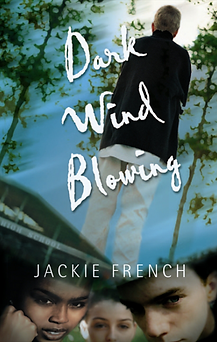

Dark Wind Blowing
Mike is just like any other normal kid - he lives with his mum in an ordinary house, in a small town, where nothing unusual ever happens. His next-door neighbour is Lance Loosley, a boy who's known at school as 'Loser' because he's so unpopular. Loser tells Mike that 'Tenterfield' - the old property nearby, which was recently bought by some foreign investors is being used as a laboratory to run dangerous experiments. Of course, Mike doesn't believe Loser for a second. He's always concocting stories to make himself look good. But one day at school, Loser is pushed too far by the other kids. this time the humiliation and teasing is too much, and Loser seeks revenge. He smashes a test tube in class, a test tube that he says contains a deadly virus from the 'Tenterfield' property. Is Loser telling the truth? Have they all driven him into becoming a killer? Will they all die from the virus?
Inspiration behind book..
I wrote Dark Wind Blowing as a book about bullying, but not because I was bullied.
The year before I wrote it my son and I drove past a suburb in Canberra called Bruce. I giggled and said 'I used to know a kid called Bruce. He was IMPOSSIBLE.'
I started to tell him some stories about how Bruce had worn dorky clothes, and was really bad at a game we all played back then and.. My son looked at me with horror. 'Mum, you were a bully.'
'No I wasn't. It was just that he was so...' I stopped. Because of course he was right. I had been a bully, and so had my friends. We had never played tricks on Bruce. We had included him in our activities. But we HAD laughed at him. Suddenly I realised how much we must have hurt him- and how that hurt may have made him so nervous and lacking confidence that he made even more mistakes.
I am deeply ashamed of what I had done so unthinkingly.
Violent bullies are often repeating the violence that is done to them. But bullying can be contagious. Once someone has been chosen as a scapegoat, the bullying can escalate. I was sometimes laughed at - though only a bit- for being different at school, coming up with the ideas that now are turned into books or correcting my teachers when they made a mistake about ancient Greek philosophy or didn't know much about the agricultural economy of Nigeria. (Some teachers enjoyed this. Others sighed. One failed me for 'not sticking to the text book' but luckily there was an external exam that year (Year 10) and I got the highest possible mark, so it didn't matter.) I learned slowly not to show that I was brighter or more imaginative than others at school.
But maybe I was all the more ready to laugh at Bruce because that meant he was the group's scapegoat, not me.
Why are the main characters kids? Because it is a book for kids, but also that is the time when we learn much of the behaviour we use as adults.
What is the meaning of the book? Be compassionate. If someone is doing something dumb, or trying to show off, try to understand why they are doing it, and sympathise. It is never right to laugh at someone. Laugh with them, but not at them.
And be kind. Kindness is contagious. The more kind you are, the more it will spread. Hatred is contagious too. You might like to look at Pennies for Hitler, too, to see this theme developed on a wider scale.



